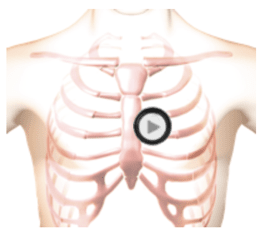Acute Pericarditis Auscultation Lesson with Recordings
Virtual Auscultation


The patient's position is sitting leaning forward.
Lesson
This is an example of acute pericarditis as auscultated at Erb's Point. Murmurs are caused by turbulent blood flow across incompetent or stenotic valves. In contrast, a pericardial friction rub is caused by the rubbing together of two surfaces of the pericardial sack. The pericardial friction rub has three parts; a systolic component, an early diastolic component and a late diastolic component. The first and second heart sounds are obscured by the rubbing sounds. In the anatomy video you can see the yellow fluid accumulation around the heart caused by an inflamed pericardial sack.Waveform
Heart Sounds Video
Review the cardiac animation and notice the yellow fluid accumulation around the heart caused by an inflamed pericardial sack.
Authors and Sources
Authors and Reviewers
-
Heart sounds by Dr. Jonathan Keroes, MD and David Lieberman, Developer, Virtual Cardiac Patient.
- Lung sounds by Diane Wrigley, PA
- Respiratory cases: William French
-
David Lieberman, Audio Engineering
-
Heart sounds mentorship by W. Proctor Harvey, MD
- Special thanks for the medical mentorship of Dr. Raymond Murphy
- Reviewed by Dr. Barbara Erickson, PhD, RN, CCRN.
-
Last Update: 12/11/2022
Sources
-
Heart and Lung Sounds Reference Library
Diane S. Wrigley
Publisher: PESI -
Impact Patient Care: Key Physical Assessment Strategies and the Underlying Pathophysiology
Diane S Wrigley & Rosale Lobo - Practical Clinical Skills: Lung Sounds
- Essential Lung Sounds
Diane S. Wrigley, PA-C
Published by MedEdu LLC - PESI Faculty - Diane S Wrigley
-
Case Profiles in Respiratory Care 3rd Ed, 2019
William A.French
Published by Delmar Cengage - Essential Lung Sounds
by William A. French
Published by Cengage Learning, 2011 - Understanding Lung Sounds
Steven Lehrer, MD
- Clinical Heart Disease
W Proctor Harvey, MD
Clinical Heart Disease
Laennec Publishing; 1st edition (January 1, 2009)